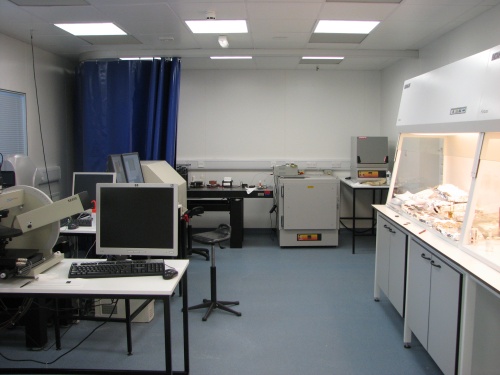SRDG Material Characterisation Lab
SRDG Material Characterisation Lab
Location: 209a
SRDG/ SHEFC funded cleanroom for use in materials characterisation for future Gravitational Wave Detectors
This award has enabled the refurbishment of an existing space from a general lab area to a specialised facility for the characterisation of materials and components for use in gravitational wave searches. Existing ground-based gravitational wave detection projects such as LIGO, GEO600 and VIRGO are currently searching for gravitational waves from astrophysical sources. These projects use large scale interferometers to try to detect very small fluctuations in the positions of delicately suspended mirrors, caused by gravitational waves passing through the interferometers. The detection of these waves should give us unique new information about some of the most violent and interesting astrophysical processes in the Universe.

In parallel, research is ongoing towards the development of a space-based gravitational wave detector LISA, with portions of the flight hardware for its demonstrator mission LISA Pathfinder being constructed in Glasgow.
A planned second generation of ground-based gravitational wave detectors will utilise new technologies to produce devices of unsurpassed sensitivity. These will incorporate sophisticated optical and mechanical systems, with significant research and development of these systems being carried out in the IGR in Glasgow. In the materials characterisation suite we have a variety of tools which allow rigorous characterisation and quality control of the optical components which form critical components in our research and development in areas such as the hydroxy-catalysis bonding of oxide materials and studies of the thermo-mechanical properties of low loss dielectric ion-beam-sputtered optical coatings.
These will be essential in allowing the upgraded experiments to reach their design performance potential, in underpinning developments for future '3rd generation' gravitational wave facilities, and in supporting our spin-offs of the technology developed for gravitational wave detectors into other fields of research.
The new Materials Characterisation Suite includes:
- Zygo interferometer
- Wyko automated optical surface profiler
- Hitach TM1000 SEM
- Sample preperation and cleaning facilities
- Nomarski Microscope
- Polytec Vibrometer
- Spectroscopic Ellispsometer
- Contact Angle Measuring Instrument
The award also underpins our materials related research, and the functioning of the Materials Characterisation Lab through the purchase of components for a high-vacuum Kelvin probe, an evaporator for metal coating test samples, a 100W CO2 laser for welding of pulled fibres and items of supporting electronics. In particular, our work is supported by the purchase of a HAAS VM-2SE fully automated 5-axis vertical milling centre for manufacturing large mechanical structures and small complex precision parts.
Contact Liam Cunningham
